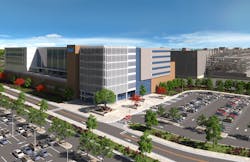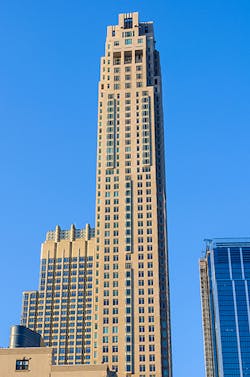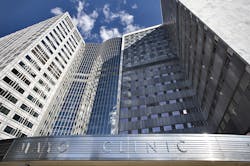While contractors remain concerned about finding qualified talent, astronomical price increases in basic construction materials and COVID-related jobsite restrictions, 2022 should be a solid year for the construction market. When you consider that the electrical portion of a typical construction project is roughly 10% of the total cost, the potential revenue impact any of these projects would have on electrical distributors, reps, manufacturers, electrical contractors, design and engineering firms and others in their local markets’ electrical construction communities is substantial.
The table below offers information on 50 of the largest projects either underway or nearing their start data. EW’s editors also profiled several trophy jobs in some particularly active construction market niches that may offer electrical construction professionals solid business opportunities in the very near future: Here are the projects featured in this article:
- Electric vehicle & battery plants —Ford Motor Co.’s plans for new battery & EV plants in Kentucky and Tennessee
- Commercial solar installations – The innovative solar roofs Google has installed at two of its campuses in Mountain View, CA
- Semiconductor plants – Intel’s plans for a huge semiconductor manufacturing hub in Licking County, OH, near Columbus
- Office-to-apartment conversions – The recently completed One Wall Street project in New York
- Large-scale, mixed-use projects — Hall Park in Frisco, TX
Hospital projects — The Mayo Clinic’s 20-year expansion plan for its facilities in Rochester, MN
If you need this type of project data on a regular basis, Electrical Marketing (www.electricalmarketing.com) offers quarterly project updates as part of a $99 annual subscription.
FORD’S MULTI-BILLION DOLLAR EV & BATTERY FACTORIES
Glendale, KY and Stanton, TN
A Sept. 28 press release said the move is “the largest ever U.S. investment in electric vehicles at one time by any automotive manufacturer,” and that together with its partner, SK Innovation, it will create nearly 11,000 new jobs at the Tennessee and Kentucky mega-sites near Louisville, KY, and Memphis, TN.
“An all-new $5.6 billion mega campus in Stanton, TN, called Blue Oval City, will create approximately 6,000 new jobs and reimagine how vehicles and batteries are manufactured. Blue Oval City will become a vertically integrated ecosystem for Ford to assemble an expanded lineup of electric F-Series vehicles and will include a BlueOvalSK battery plant, key suppliers and recycling,” the press release said. “Ford’s new Tennessee assembly plant is designed to be carbon neutral with zero waste to landfill once fully operational.”
In Glendale, KY, approximately 56 miles south of Louisville, Ford plans to build a dedicated battery manufacturing complex with SK Innovation – the $5.8 billion BlueOval SK Battery Park – creating 5,000 jobs. The release said twin battery plants on the site are intended to supply Ford’s North American assembly plants with locally assembled batteries for powering next-generation electric Ford and Lincoln vehicles. Investments in the new Tennessee and Kentucky battery plants are planned to be made via BlueOvalSK, a new joint venture to be formed by Ford and SK Innovation, subject to definitive agreements, regulatory approvals and other conditions.
Ford reportedly has more than 150,000 orders for its new F150 Lightning EV. Along with announcing plans for the two new facilities in Tennessee and Kentucky, the company also said it’s investing $250 million in an expansion of three southeast Michigan facilities, including its Rouge Electric Vehicle Center that will create 450 new hourly jobs.
Ford isn’t the only auto manufacturer making massive investments in the EV market. In late January, General Motors announced that would invest $7 billion in a new battery plant in Michigan and an existing plant outside Detroit. According to a report in the New York Times, GM’s investment will create 4,000 jobs and will be financed in part from the state of Michigan’s $824 million in economic incentives. Over the past year, several other auto manufacturers announced plans for EV or battery plants, including Toyota, which will be building a new $1.3-billion battery plant near Greenville, NC, and Rivian, which plans to invest $5 billion in an EV facility east of Atlanta.
GOOGLE’S DRAGONSCALE ROOFS
Mountainview, CA
As part of their goal to operate on entirely carbon-free energy by 2030, Google has developed a “dragonscale” solar roof at its Charleston East office and at its Bay View research facility at NASA’s Ames Research Center in Mountainview, CA. According to Google, the dragonscale is a first-of-its kind design made up of 90,000 silver solar panels with the capacity to generate nearly 7 megawatts (MW) of energy.
Google said the idea for the new roof came from a desire to prioritize alternate sources of energy, like solar, and maximize the amount of solar energy that their buildings could capture. Asim Tahir, the District Renewable Lead at Google, said in a post on a blog at its corporate web site, “When the designs for our newest additions to our Silicon Valley campus evolved into a large, canopy structure, we knew we had to think beyond traditional rectangular solar panels to create something that balanced form and function. Today, the two main developments that have this solar roof, Bay View and Charleston East, are nearly complete.”
“These panels coupled with the pavilion-like rooflines let us capture the power of the sun from multiple angles,” Tahir said in the post. “Unlike a flat roof, which generates peak power at the same time of the day, our dragonscale solar skin will generate power during an extended amount of daylight hours. This will limit our contribution to California’s notorious duck curve — which tracks the difference between energy demand and the available solar energy throughout the day. When up-and-running, Charleston East and Bay View will have about 7 MW of installed renewable power—generating roughly 40% of their energy needs.”
Solar panels like the dragonscale that are integrated into the design of the building, rather than added later, are known as building-integrated photovoltaics (BIPV). Integrating solar panels into a roof is one approach to using BIPV. Google hopes to further develop this approach for future projects.
INTEL SEMICONDUCTOR FACTORIES TO BRING CHIP MANUFACTURING BACK TO AMERICA
Licking County, OH
According to the press release, the site will span nearly 1,000 acres in Licking County, just outside of Columbus, and can accommodate a total of eight chip factories — also known as ‘fabs.’
“At full buildout, the total investment in the site could grow to as much as $100 billion over the next decade, making it one of the largest semiconductor manufacturing sites in the world,” said the press release. Construction is expected to begin late in 2022.
The news follows Intel’s March 2021 announcement that it’s investing $20 billion into its Fab 42 semiconductor facility on its Ocotillo campus in Chandler, AZ. Other semiconductor manufacturers have also announced plans to build new facilities, including Samsung, which last year said it will build a $17-billion plant in the Austin metro. Taiwan Semiconductor is also building a $12-billion chip facility in the Phoenix area. The company expects to start volume production of its 5-nanometer in 2024.
If legislation currently being discussed in Congress for $52 billion in federal subsidies for domestic semiconductor production and research is signed into law, you can expect a surge in construction of the facilities. The Biden Administration supports the concept, the Senate has already passed its version of a semiconductor subsidy bill and according to a Jan. 25 Reuters report, the U.S. House of Representatives will begin debating legislation in February. Semiconductor plants take years to complete, but because of number of them on the drawing boards, they will eventually account for a large share of industrial construction spending.
OFFICE-TO-APARTMENT CONVERSIONS
New York
One of the larger office-to-apartment conversions is the recently completed $1.5-billion One Wall Street job in the heart of the Big Apple’s financial district. Macklowe Properties completed the conversion of a 90-year-old, 654-ft tall Art Deco office building into 566 apartments, a 44,000-sq-ft Whole Foods Market and a LifeTime fitness center.
Developers are also converting schools, factories, hospitals and other properties into apartments. According to an analysis of YardiMatrix data by www.rentcafe.com, Philadelphia leads the nation in total converted properties and over the past two years developers in the city have added 1,863 apartment units to Philly’s multi-family housing stock.
HALL PARK -$7 BILLION IN MIXED-USE DEVELOPMENT
Frisco, TX
BILLIONS OF DOLLARS INVESTED IN HOSPITAL CONSTRUCTION
Rochester, MN
The $1-billion California Northstate University medical center underway in Sacramento, CA, and the $1.2-billion Wexner Inpatient Hospital Tower on the Ohio State University campus are two of the larger hospital projects now underway.
About the Author
Jim Lucy
Editor-in-Chief of Electrical Wholesaling and Electrical Marketing
Jim Lucy has been wandering through the electrical market for more than 40 years, most of the time as an editor for Electrical Wholesaling and Electrical Marketing newsletter, and as a contributing writer for EC&M magazine During that time he and the editorial team for the publications have won numerous national awards for their coverage of the electrical business. He showed an early interest in electricity, when as a youth he had an idea for a hot dog cooker. Unfortunately, the first crude prototype malfunctioned and the arc nearly blew him out of his parents' basement.
Before becoming an editor for Electrical Wholesaling and Electrical Marketing, he earned a BA degree in journalism and a MA in communications from Glassboro State College, Glassboro, NJ., which is formerly best known as the site of the 1967 summit meeting between President Lyndon Johnson and Russian Premier Aleksei Nikolayevich Kosygin, and now best known as the New Jersey state college that changed its name in 1992 to Rowan University because of a generous $100 million donation by N.J. zillionaire industrialist Henry Rowan. Jim is a Brooklyn-born Jersey Guy happily transplanted with his wife and three sons in the fertile plains of Kansas for the past 30 years.







